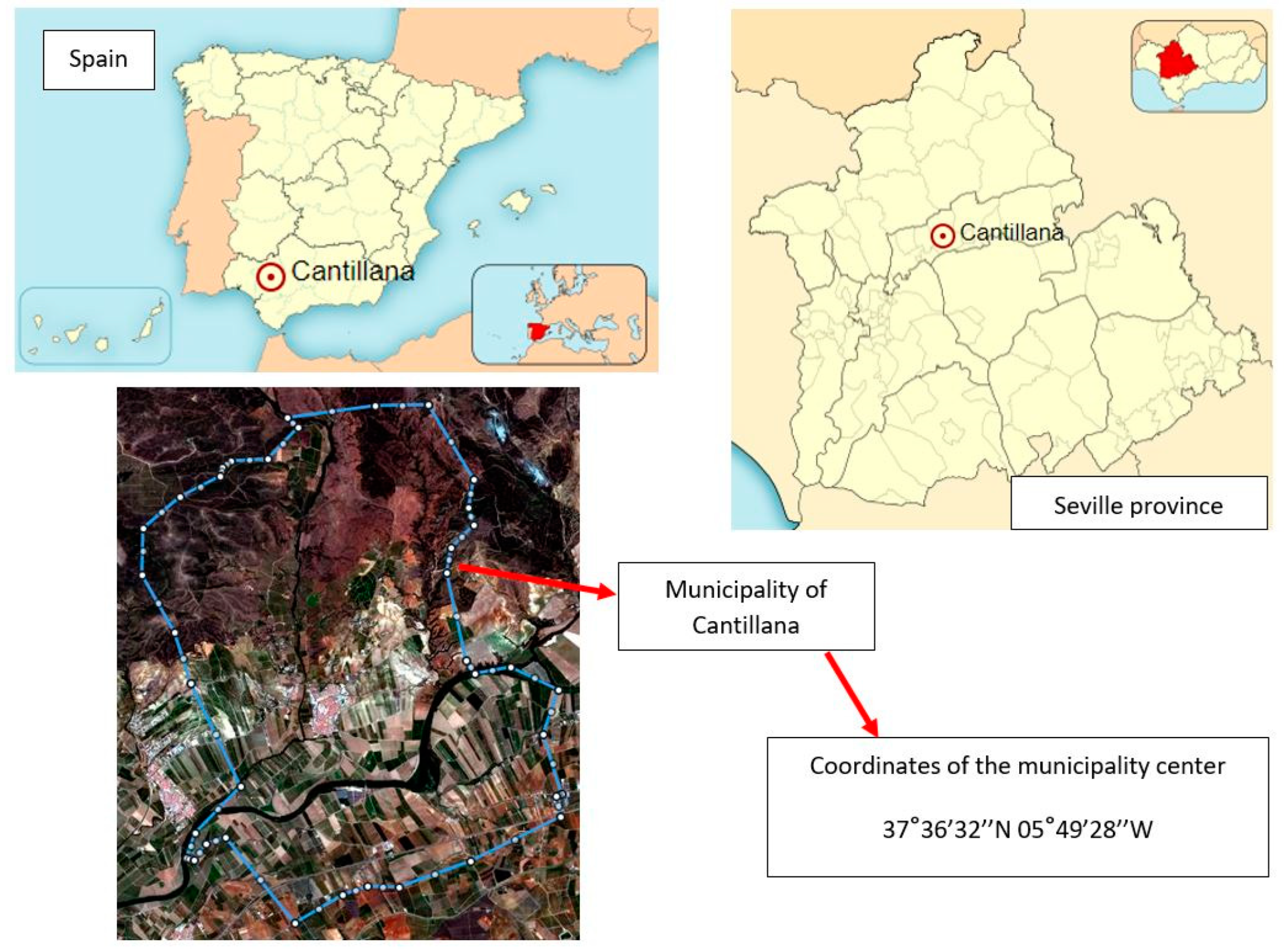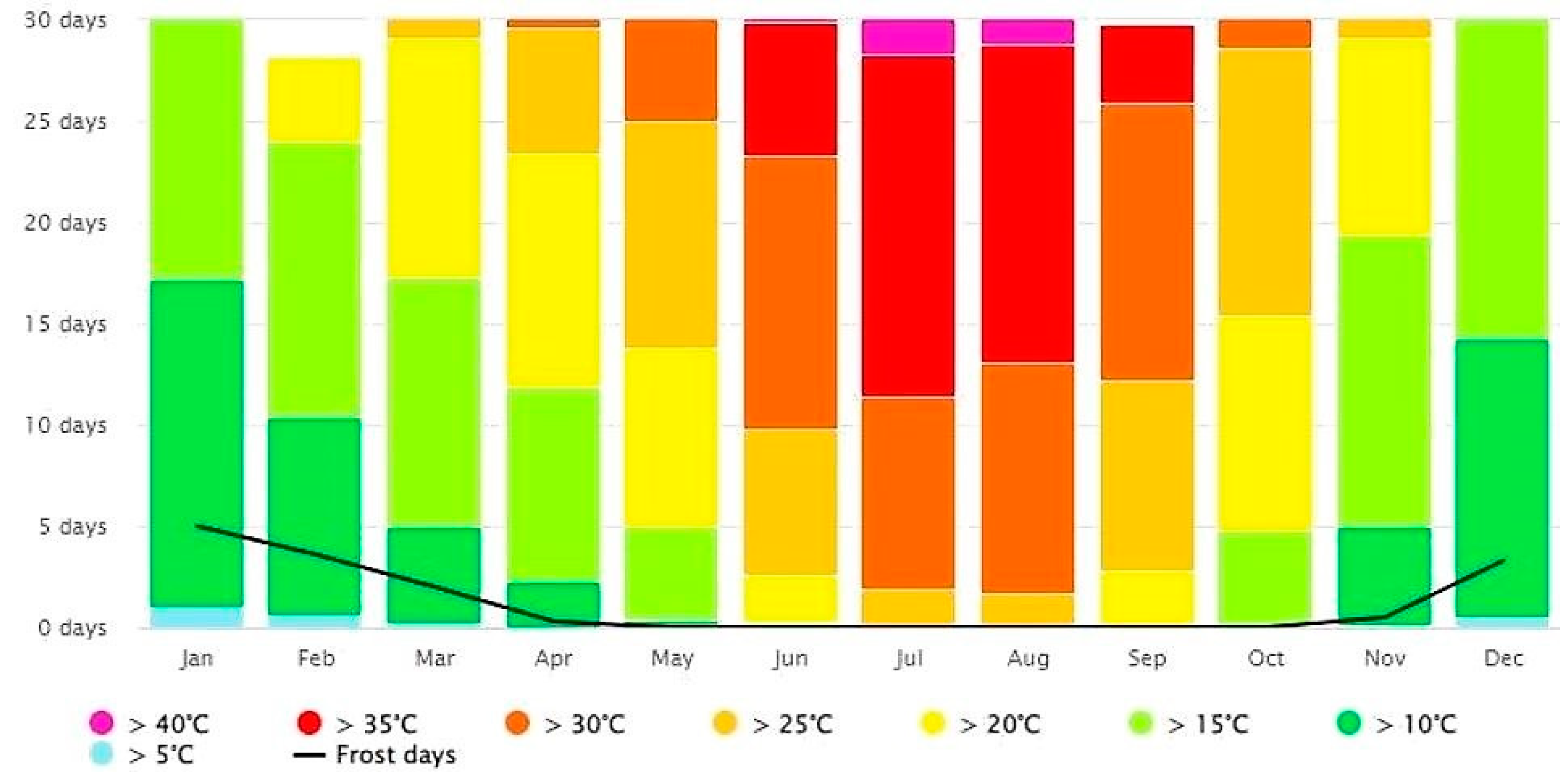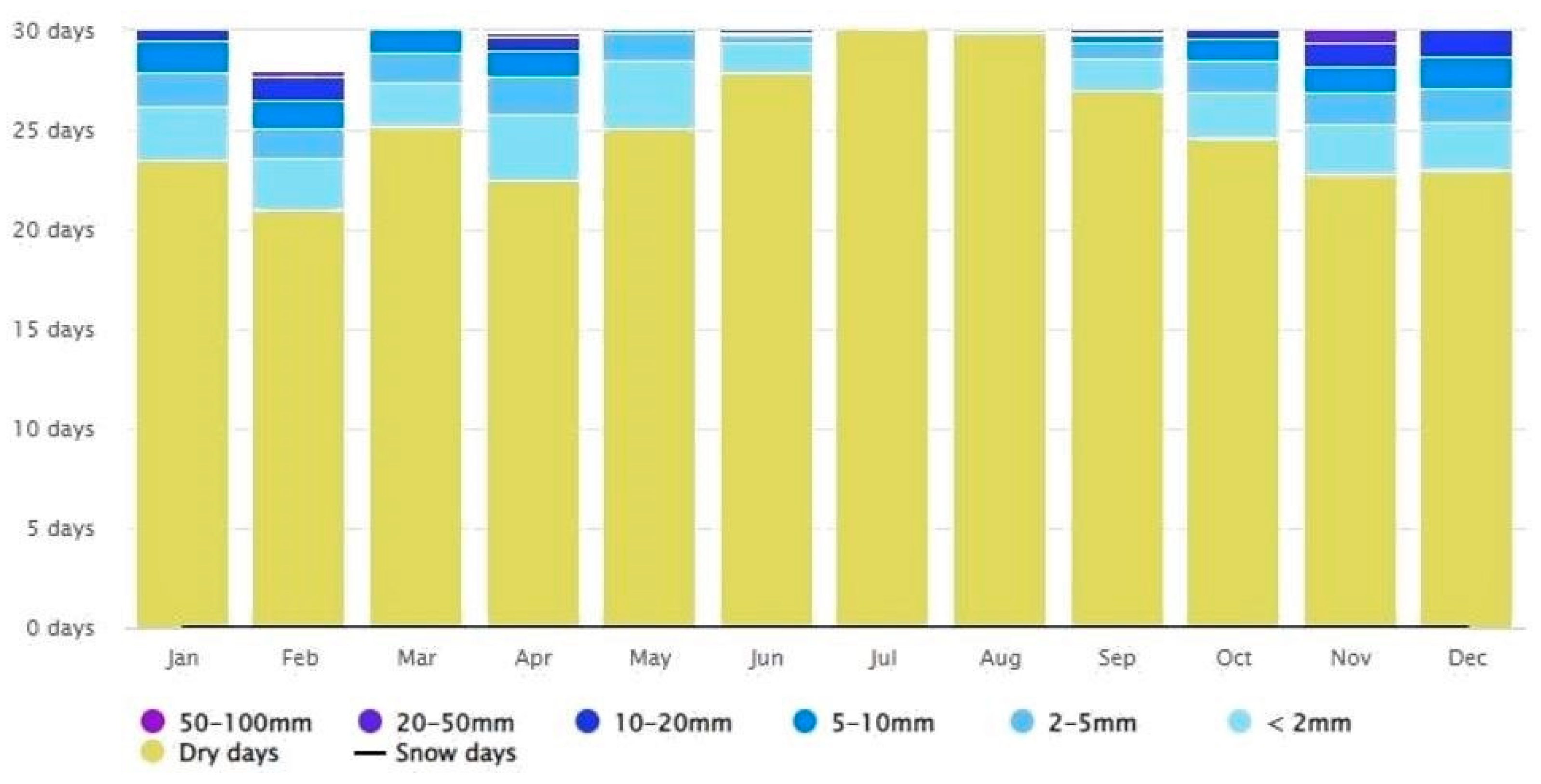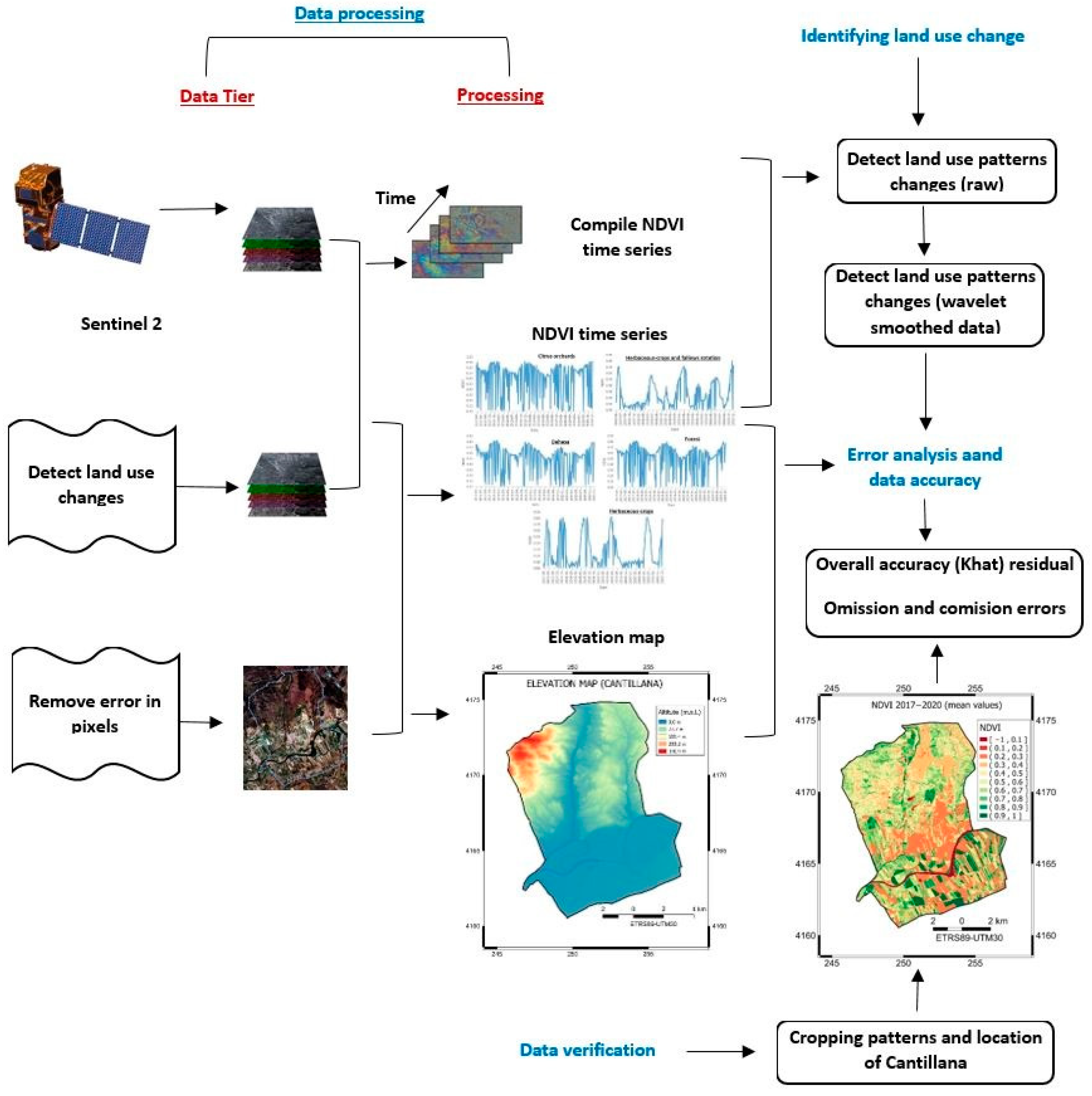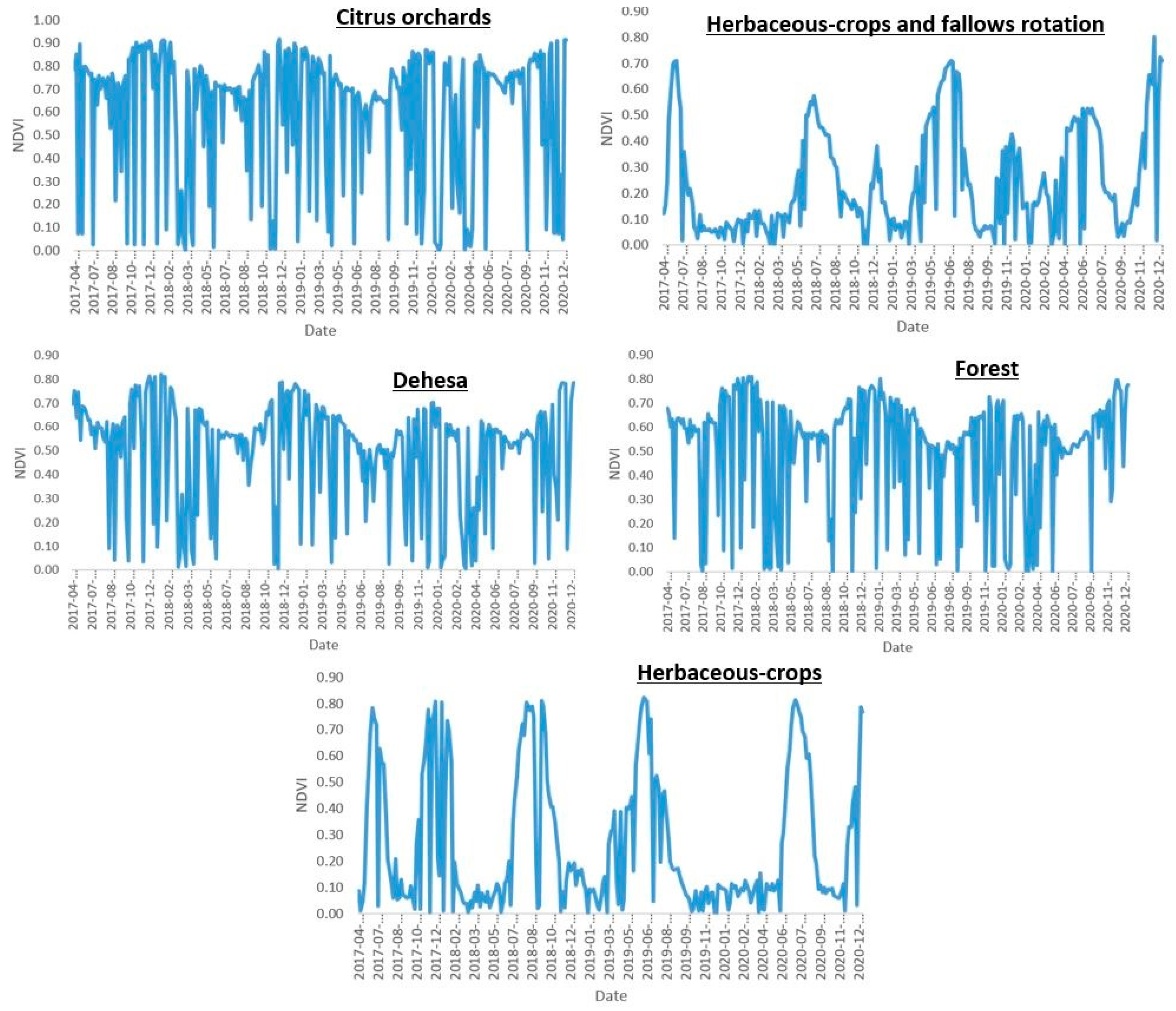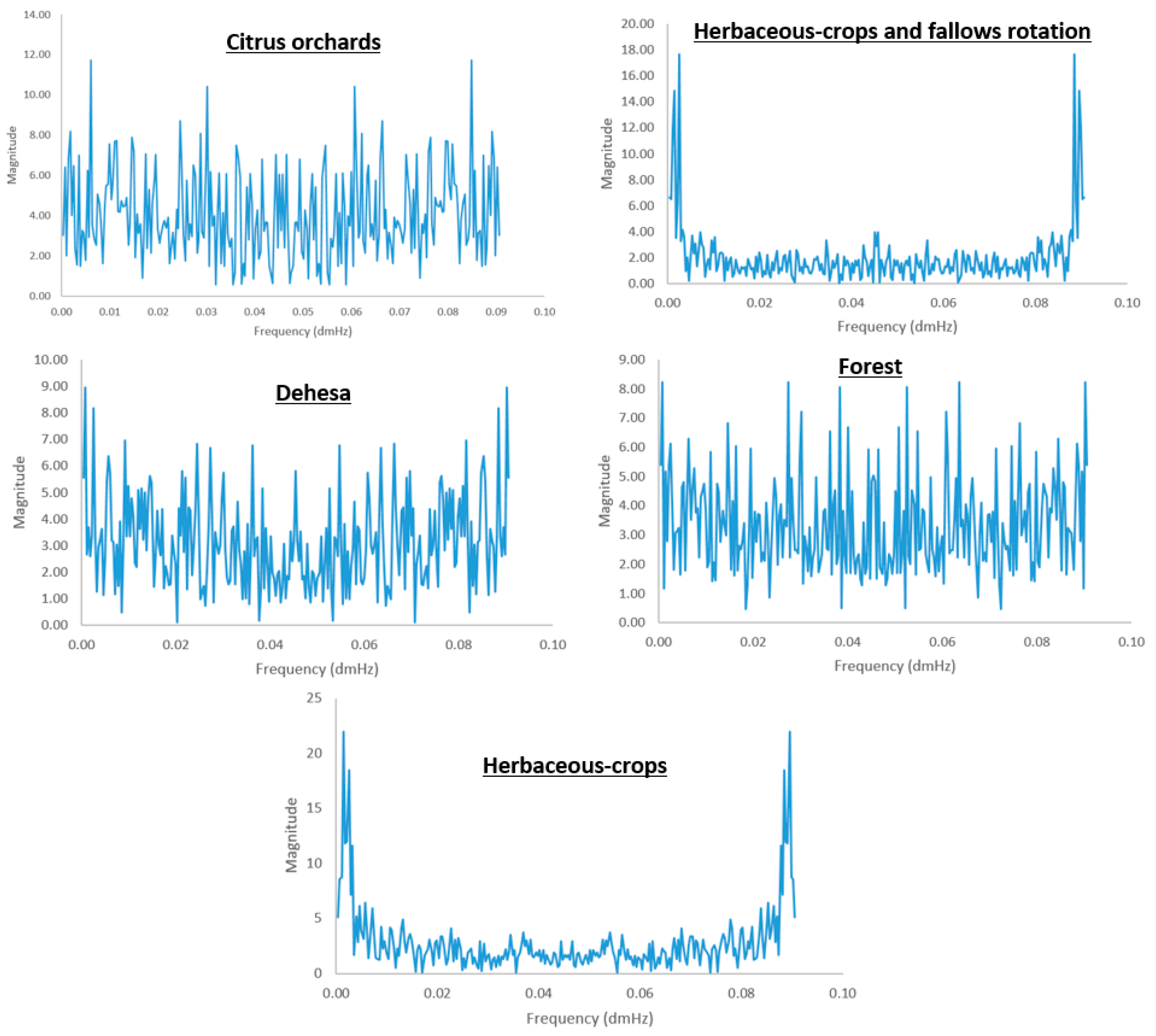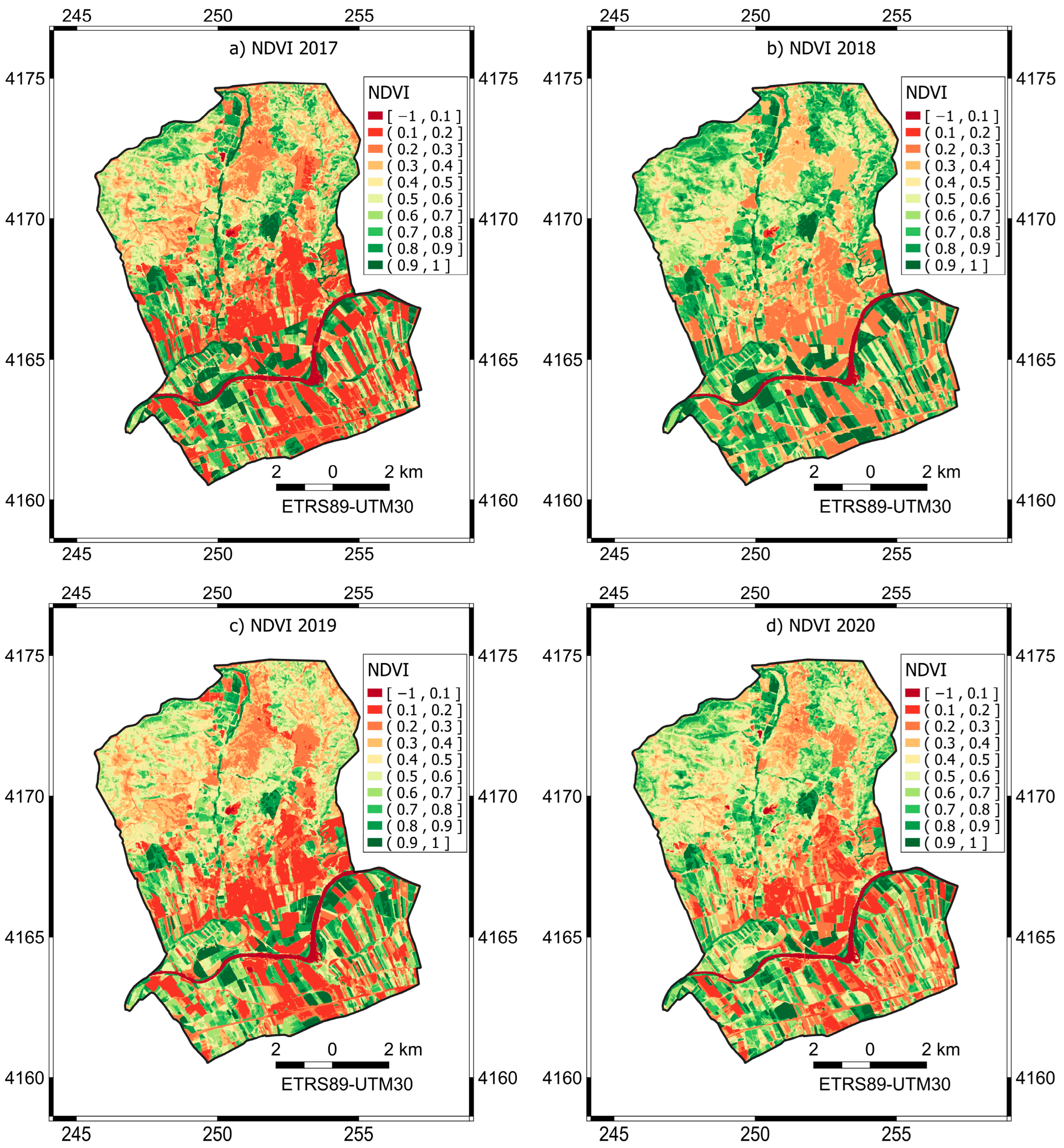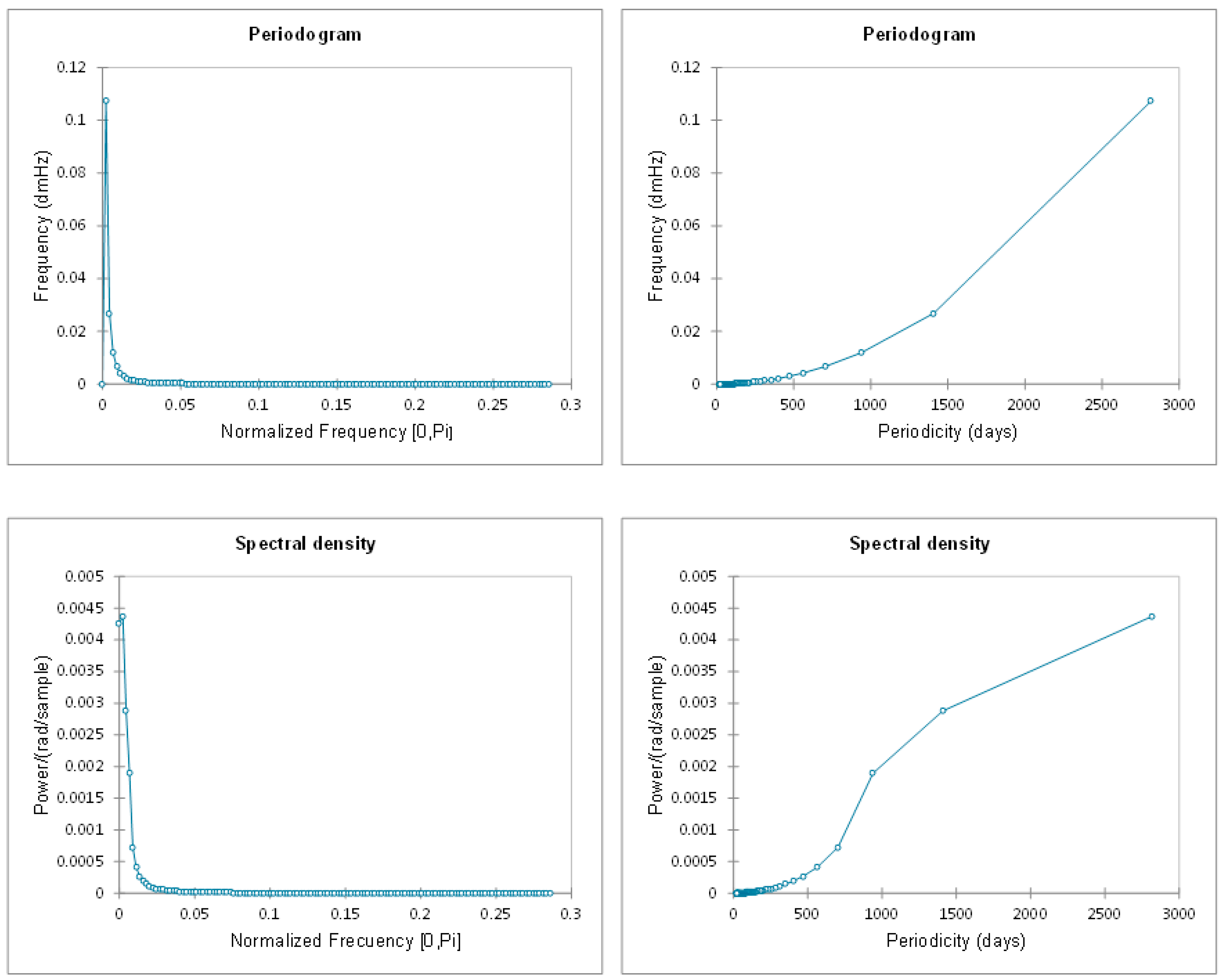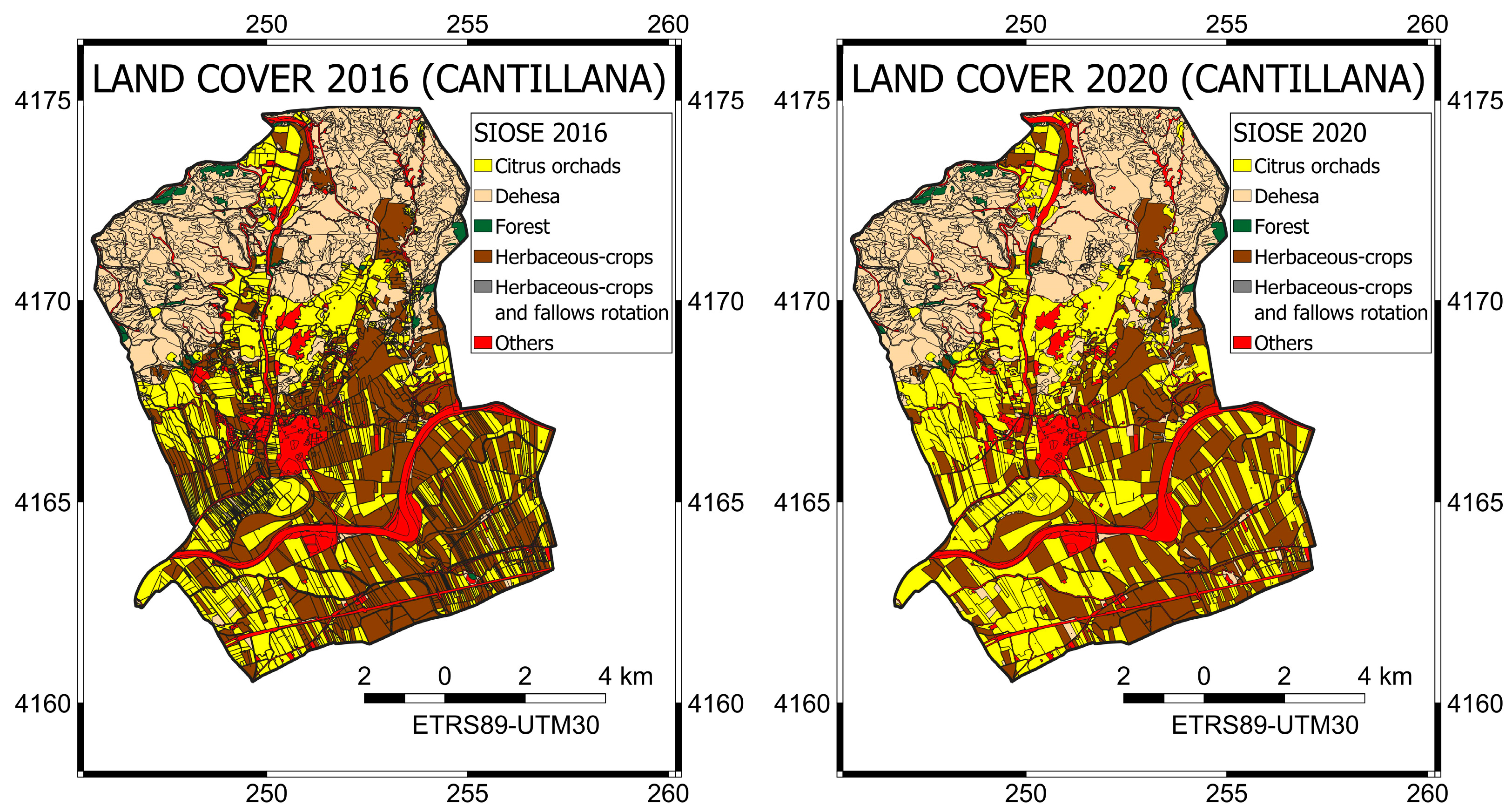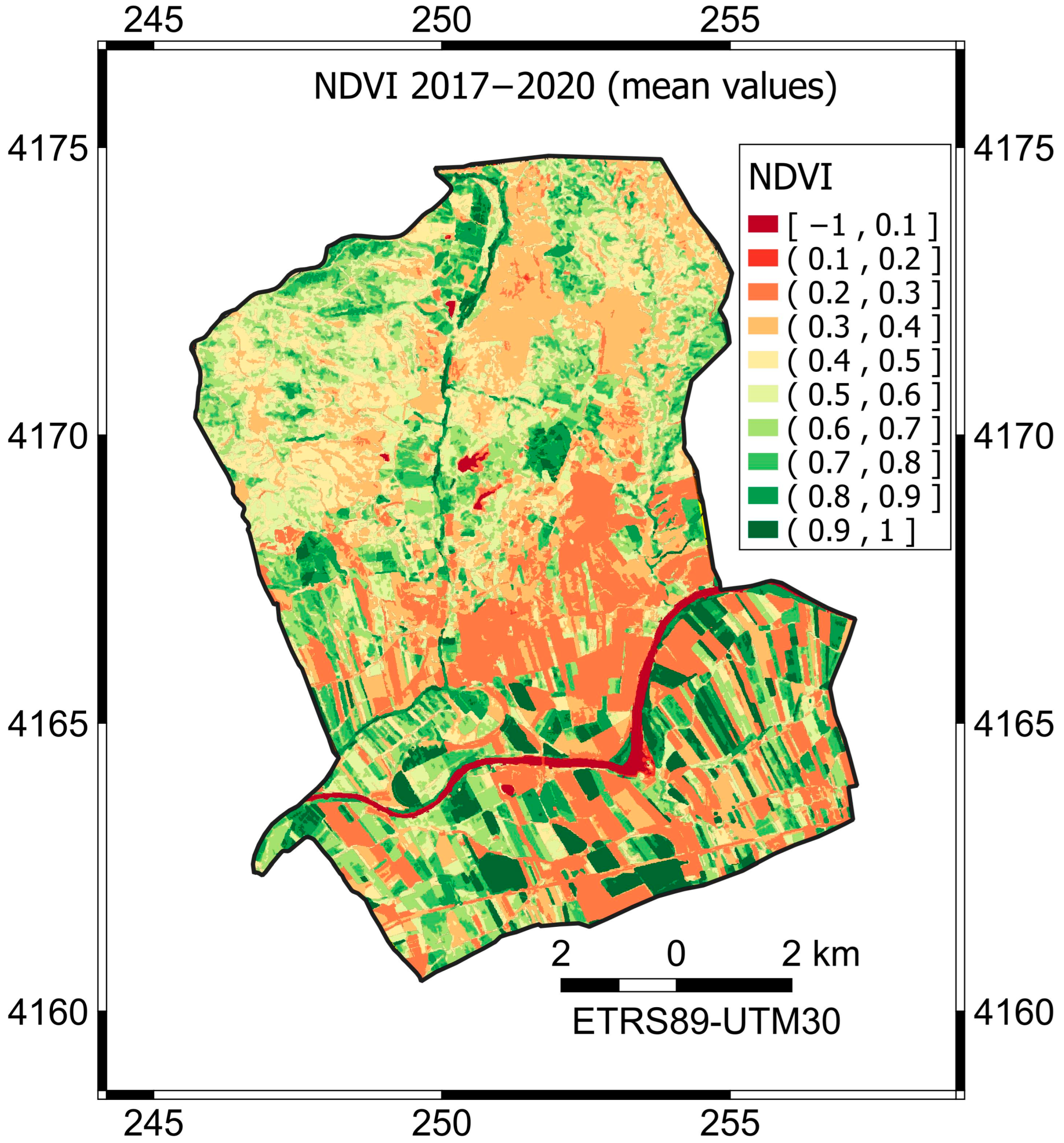1. Introduction
In the 1980s, while the global economic integration process of the Spanish economy intensified, multiple experiences of local development arose and developed as a response to the unemployment and backwardness in many Spanish municipalities. In the Autonomous Community of Andalusia, it had its expression in those municipalities belonging to the regions of Montilla, Cabra, Lucena, and Puente Genil, located in the province of Córdoba, El Condado, located in the province of Huelva, and Antequera, located in the province of Malaga [
1]. The objective was to reduce poverty, create employment, and promote economic and social progress. The driver was constituted by local agents and communities, which promoted economic initiatives with the purpose of facing the challenges posed by productive adjustment and the growing competition in national and international markets. This event did not occur in Cantillana, in the province of Seville.
However, since mid-2007, the Spanish economy, like the economies of many other countries, has been affected by the international crisis of the financial system. This fact caused a blockage in economic functioning in addition to a decrease in both productive activity and internal and external demands. Likewise, there was growth in the unemployment rate and a subsequent increase in poverty. This final consequence led to a noticeable worsening of the economic fabric of towns located in the most depressed areas of the country in the case of Andalusia, mainly its villages [
2]. In this regard, it is necessary to comment that Cantillana reached an unemployment rate higher than 50% [
3].
As is well known, an economic crisis such as the one that occurred cannot be resolved solely by applying monetary policies. On the contrary, it is necessary to design policies that stimulate the quantitative expansion of the money in circulation in order to activate demand. On this basis, it is a treatment that combines actions to recover consumer confidence to make the financial system work with initiatives aimed at improving both productivity and competitiveness [
4]. In short, it is a matter of implementing different economic development strategies in this area where local development initiatives play a determining role. Mainly, this is because they shape their strategies through a territorial approach that aligns closely with the social and productive conditions of the specific municipality while always being rooted in the examination and enhancement of local internal factors [
2].
To effectively engage with the productive system, it is crucial to recognize that the agricultural actions and decisions to be made will occur within distinct regions marked by the unique social, institutional, and cultural contexts with which they interact. In this context, the essential factors include the agricultural potential present in the specific area in question and the organizational capabilities of local stakeholders [
2]. It is precisely from this perspective that local initiatives must be articulated. The reason is that the territories have a set of resources that constitute their development potential. In the case of Cantillana, one of the pillars is citriculture.
In this regard, Cantillana constitutes a dominant sector over all the others, the agricultural sector, and within this, citrus cultivation is what historically has been the major economic source of the municipality. Currently, this woody crop occupies more than 64.5% of the irrigable area (and continues to increase) and around 45% of the entire agrarian area used for agriculture [
2]. For this reason, due to the importance of citrus-related economic activity in the municipality of Cantillana, a pioneering research project [
2] was carried out via a public initiative (from 3 August 2015 to 3 August 2020). This project, through the use of geographic information systems (GIS) and remote sensing tools, was intended to increase the profitability and competitiveness of citrus farms. To achieve this objective, a technology transfer was carried out and specially designed in the form of patents, utility models, and industrial designs.
Regarding the above, it must be emphasized that the agricultural development of Cantillana has a strong dependence on the agricultural policies carried out previously. For this reason, and given that land use changes continue to occur today as a consequence of the prevalence of the aforementioned agrarian policies, its presentation is vital to adequately understand the results and discussion of this work.
Furthermore, by employing GIS and remote sensing technology, along with comprehensive climate data comprising temperature and rainfall records, it becomes possible to establish the correlations between these variables and the various specific conditions observed at the plot level [
5,
6]. With this, sustainability and eco-design parameters can be established that allow an optimal adjustment of the available resources, as well as an improvement in production levels through the minimum and necessary use of inputs.
Logically, the quality of the obtained product (orange fruit) is one of the factors to take into account, which is why technology transfer strategies, as well as local initiatives, have to be linked with the purpose of improving it.
On the other hand, regional changes in land cover and land use can have important implications for the environment and agriculture, leading to alterations in carbon and nitrogen storage, surface water quality, trace gas emissions, and biodiversity [
7,
8,
9,
10,
11,
12,
13]. Thus, the first step in comprehending the consequences of agricultural expansion and intensification is to identify the spatial and temporal patterns of this phenomenon. This information is critical for determining the long-term impacts on crop production, as well as agricultural sustainability, the environment, and the economy.
As is well known, remotely detected green leaf phenology is a useful measure for distinguishing between different types of land cover and land use changes, particularly in agricultural settings. The croplands’ phenology is more complicated than that of natural land cover, owing to the numerous peaks that arise from the successive planting of multiple crops during a single growing season. Moreover, the homogeneous coverage of green leaves in agricultural fields results in extremely high observed greenness, specifically when contrasted with the barren soil that remains following harvest. Over time, the substantial range of cropland green vegetation is influenced significantly by natural factors, such as the amount and temporal rainfall variability, and management choices, including the time of planting and the crop variety used. In this sense, the studies carried out by [
14,
15,
16] are of great importance.
It is widely acknowledged that vegetation plays a significant role in agricultural ecosystems, as highlighted in references [
14,
15]. Consequently, the Normalized Difference Vegetation Index (NDVI), closely linked to measures such as green biomass and leaf area indices at different levels (regional, national, or international), has gained extensive recognition for its utility in examining alterations in terrestrial vegetation patterns and its capacity to capture photosynthetically active radiation (fAPAR) by canopy [
15].
Phenology studies typically apply curve-fitting algorithms to simplify parameterization and identify metrics such as the start of the season. Land cover can be identified from specific characteristics of green leaf phenology, including the season onset, dry season minimums, and amplitude of maximums, as demonstrated in previous studies [
17,
18]. A multi-point smoothing function is the simplest way to create a smoothed time series, but it may not effectively remove high-frequency noise. Other curve-fitting approaches [
17] use a harmonic curve-fit to characterize the inter-annual variability of a time series. A sigmoid curve-fitting algorithm [
18,
19] can be applied to a single year’s time series, but it requires an understanding of the prior system’s seasonality to spot the phenological peaks [
18,
19,
20].
Several methods have successfully identified cropping systems in certain environments, but these are not effective for Cantillana agriculture for three reasons. First, multi-point smoothing functions cannot eliminate high-frequency noise driven by the long rainy season, which would require a finely tuned crop detection algorithm that accounts for the precipitation gradients in the area. Second, using average annual phenology to identify land cover fails to capture the inherent variability of the system [
17], which can change dramatically yearly. Fourier transforms are also unsuitable due to the non-stationary nature of the time series signal, more appropriately addressed by wavelet transforms [
21]. Third, stochastic rainfall’s nature and human action influence the calendar and spatial patterns of phenology peaks, making it challenging to predict precisely when they will occur. Additionally, certain curve-fitting algorithms, like SIGMOD, require a priori knowledge of the phenology peaks’ timing, which does not apply to this system [
18,
19].
In order to undertake the challenge of removing high-frequency noise whilst remaining sensitive to annual changes in phenology, we will follow the wavelet-based curve-fitting methodology used by Rhif et al. [
21], called the Wavelet-Based Filter for Determining Crop Phenology (WFCP). To evaluate the efficacy of this approach in a generalized context, it is crucial to ensure that it can be applied to a variety of study areas while not compromising performance or demanding extensive modifications. Our research focuses on the Guadalquivir Valley, where Cantillana is located, which offers a consistent test for the wavelet methodology due to the significant fluctuation in phenology patterns and the additional noise caused by the tropical rainy season. We have a particular interest in applying the WFCP to this area because it has demonstrated strong curve-fitting capabilities for citrus orchard phenology and has the potential to be a rapid and highly automated method.
To study highly dynamic systems, we rely on a wavelet transform for time series analysis. The wavelet analysis efficiently extracts valuable information from large datasets, including hyperspectral image cubes, seismological signals, vegetated land cover, and sea surface temperature [
21,
22,
23,
24,
25,
26,
27].
The use of wavelet analysis has been found to be effective in identifying the beginning of the growing season and the timing of harvest in agriculture applications, with a low error rate of 11 to 14 days [
21]. Wavelet analysis is well suited to agricultural patterns that occur over time and fields’ spatial heterogeneity due to precipitation and management decisions, as it is capable of localizing the transformation in time and frequency. It must be taken into account that, when cloud cover is frequent in the study area, the use of wavelet analysis is particularly desirable, as it can effectively remove high-frequency noise in a highly automated manner.
Remote sensing can provide valuable insights into the impact of the extensification and intensification in croplands on both the natural environment and agricultural sustainability. In the Vega Alta of the Guadalquivir River, where industrial-scale croplands (industrial agriculture model) are becoming more prevalent, the shift towards citrus orchards and the intensification of cropping systems can have long-term biogeochemical effects on soil fertility [
21]. Industrial agriculture is an agricultural model that aims to directly commercialize what is grown. This production method is one of the most used in the world since it is efficient enough to achieve profitable economic returns for the farmers who choose to carry it out. This type of agriculture is of enormous importance for the agrarian economy of the Guadalquivir Valley. For this reason, the main aim of this research is specified below:
By testing the effectiveness of wavelet analysis on time series data, the highlights of this study are:
The potential utility of wavelet analysis for identifying land use and land cover changes in agricultural environments close to the Viar River’s Irrigable Area;
Studying the dynamics of citrus orchards’ patterns and discussing their interconnection with the dynamics of NDVI and the topography of the study area.
The novelty of this work focuses on the fact that it is the first time that wavelet analysis has been carried out in the Vega of the Guadalquivir River. In the same way, due to the NDVI time series of land uses in the study area, this work serves as a basis for developing a territory management tool dependent on Sentinel-2 data.
4. Discussion
A large citrus orchard in the Iberian Peninsula, specifically in Cantillana, Andalusia, Spain, is taking over natural ecosystems and becoming one of the largest contiguous citrus plantations worldwide [
26]. The agricultural census offers data about the cultivated area and crop yields are insufficient beyond the municipal level. Thus, they fail to provide information on the crop sequence and duration or land use practices that affect local biogeochemistry. Fortunately, remote sensing can help establish agricultural patterns and construct a land use chronology per pixel (
Figure 10), which could have applications in understanding carbon and nitrogen cycling and estimating crop production rates’ economic impact.
The WFCP methodology, which utilizes wavelet transformation on an NDVI time series, effectively represents crop phenological behavior with minimal error [
22]. The methodology was tested under new environmental conditions, including high-frequency noise caused by clouds due to climate and different agricultural phenology than the areas where the model was originally developed and validated [
21,
26,
31]. However, as a limitation, it is important to highlight that wavelet transformation may occasionally overemphasize small phenology peaks resulting from weedy growth or create a false peak due to wavelet resonance. To address this issue, small peaks can be classified as double crops. While this classification may be problematic from a curve-fitting standpoint, it remains amenable for the purpose of picking out cropping patterns. The 90% power wavelet is used to detect false maximums or weedy growth, which often fall under the detection threshold for maximums of 0.4 NDVI and are, therefore, not tallied, leading to high overall accuracy [
21,
26,
32]. Likewise, in relation to the limitation of the method used in the present work, emphasis must be placed on the methodology used by [
14], since it does not require any interpolation or gap filings, and it considers observational uncertainties.
Distinct spatial patterns in the wavelet-smoothed time series data were observed. These patterns indicate that new areas of cropland tend to nucleate around existing croplands (see
Figure 10), and small areas of native vegetation between large cropland areas are often replaced with citrus orchards. Additionally, there is evidence of areas with single crops becoming double-cropped over time. This intensification seems to be spatially limited to the center of agricultural areas and probably describes the evolution of farming practices as croplands age. Insight into agricultural practices underpins this observation. The increase in crops observed from 2017 to 2020 could be associated with economic factors, such as high global market prices [
2]. Overall, the study area showed an increase in the number of crops grown per unit of land, resulting from either the expansion of new croplands or the intensification of pre-existing croplands from monoculture to double cropping systems.
In another vein, after analyzing the elevation map (
Figure 9) of the study area along with those corresponding to the land cover maps (
Figure 10), it can be observed that the use of dehesas predominates at higher elevations, while the number of citrus orchards increases at lower elevations. This fact affects not only the trend of NDVI (see
Figure 7) throughout the years analyzed (that is, 2017, 2018, 2019, and 2020) but also the average value of NDVI between 2017 and 2020 (
Figure 11).
In this way, the existence of a relationship between the type of land use, the elevation (the temperature decreases at higher elevations), and, logically, the topographic characteristics of the study area is evident. Because of this, the study area can be divided into two zones of interest. The first one would be located to the north of the urban area. It has a more varied relief, alternating between plains and mountains. Its average altitude varies from 50 to 150 m, rising at the western vertex, where the highest heights are reached, with Loma de Enmedio being the highest peak at 316 m. They are erosion-resistant lands formed by various types of rocks: slate and agglomerates in the lower areas, and dark-colored granites and basalts in the highest altitudes of the north. The second zone includes the city and the entire south of the municipality. In this area, the Viar River, in its descent from the mountains, has dragged clay (alluvial deposits), forming a plain known as Vega del Guadalquivir, which is very suitable for citrus orchards.
After conducting this study, it is crucial to emphasize that the first-order derivative characteristics, wavelet coefficients obtained through continuous wavelet transformation, and remote sensing spectral analysis features obtained using a convolutional neural network model can serve as inputs for a partial least squares model, respectively. Validating the optimization of these characteristic features is essential for efficient chlorophyll content detection. It remains to be investigated whether selecting robust features from the remote sensing spectral analysis features can enhance model performance by eliminating redundant information among the features. Furthermore, future endeavors could encompass the following: (a) expanding the spectral data across multiple years to construct a larger dataset; and (b) identifying robust features and applying the detection model to assess other crops, thus verifying the suitability and applicability of the proposed method.
5. Conclusions
The primary aim of this study was to uncover changes in land cover and land use patterns, specifically focusing on single and double cropping practices, through the utilization of time series analysis. A key challenge in the process was the identification of crop patterns within agricultural areas. To address this issue, we employed the wavelet transformation technique to filter noisy NDVI time series data. We established an annual standard deviation threshold and determined each year based on the local minimum in a bimodal histogram of standard deviations to pinpoint citrus orchard areas. This enabled us to analyze cropping patterns for a pixel only after it had been designated as a citrus orchard, thus streamlining the processing time. Subsequently, we generated a wavelet-smoothed time series using the 90% power wavelet. Phenological peaks, represented by local maxima, were considered indicative of crops if the time series exceeded a 0.4 NDVI threshold. This cutoff value was employed to eliminate false peaks that could arise in the wavelet-smoothed time series.
The reason for choosing this study area was to validate the proposed model in a region marked by the rapid expansion of citrus orchards. Over the course of the four-year study, the total cropland area increased by 980 hectares. There was also a noticeable intensification of citrus orchards, initially in the form of single-crop orchards, followed by subsequent growth in double-crop orchards. This pattern was anticipated because the expansion of citrus orchards typically begins with single-crop patterns in the first growing season and then shifts to agricultural intensification or a transition from single-crop to double-crop cultivation in the following years. Geographically, the expansion of citrus orchards occurred at the borders of existing agricultural areas, while intensification took place within already established croplands.
The study area exhibited a significant expansion in cropland, underscoring the importance of comprehending how this alteration in land cover affects the cycling of carbon and nitrogen. It is critical to differentiate between various crop types because they have distinct implications for carbon and nitrogen cycling. The inadequate management of these crops over time could result in the depletion of carbon and nitrogen, diminishing soil fertility and potentially affecting the sustainability and management of land use. Additionally, secondary crops such as olive tree orchards may require substantial amounts of nitrogen fertilizers, which can lead to increased emissions of nitrous oxide and have an impact on local water quality. Hence, possessing information regarding the quantity and nature of crops in the area is essential for developing precise spatial models that account for biogeochemical changes associated with agricultural expansion and intensification. This observation is crucial for the development of a land management tool reliant on Sentinel-2 data, using a NDVI time series to characterize land uses in the study area.
In this research, the wavelet approach’s stability was evidenced throughout several years of NDVI time series data. As a result, the WFCP methodology can be applied to a larger study region to examine the regional development patterns of citrus orchards. Upcoming studies could involve the parametrization of the wavelet-smoothed time series to pinpoint crop types. Additionally, there is potential to use other types of time series data, such as fractions of green vegetation via spectral mixture analysis, in the wavelet analysis method (WFCP). Finally, our work creates a paradigm for future studies applied to the Guadalquivir Valley.
